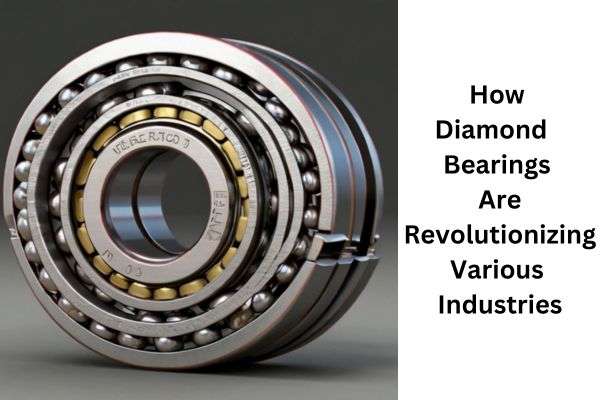
Once considered a futuristic concept, diamond bearings have become a groundbreaking innovation that has transformed numerous industries. Known for their unparalleled hardness, thermal conductivity, and resistance to wear, diamond bearings offer unique advantages that traditional bearings cannot match. This comprehensive guide will explore how diamond bearings are revolutionizing various industries, highlighting their applications, benefits, and future prospects.
Diamond bearings are engineered components made using synthetic or natural diamonds. These bearings leverage diamonds' exceptional properties, such as extreme hardness, low friction, and high thermal conductivity, to deliver superior performance in demanding applications. The advent of synthetic diamond manufacturing has made these advanced bearings more accessible and affordable, paving the way for their widespread adoption across different sectors.
Diamonds are the hardest known material, which makes diamond bearings incredibly resistant to wear and deformation. This property ensures a longer lifespan and reduced maintenance compared to conventional bearings.
Diamond bearings exhibit exceptionally low friction, which minimizes energy loss and heat generation during operation. This characteristic is crucial for applications requiring high precision and efficiency.
Diamonds have excellent thermal conductivity, which allows for effective heat dissipation. This property is particularly beneficial in high-speed and high-load applications where temperature control is critical.
Diamond bearings are resistant to chemical reactions and corrosion, making them ideal for harsh environments where other materials might degrade.
Diamond bearings are used in aerospace components such as gyroscopes, jet engines, and satellite mechanisms. Their durability and low maintenance requirements are critical for the reliability and safety of aerospace systems.
Diamond bearings are employed in medical devices like MRI machines and surgical instruments. Their biocompatibility, precision, and resistance to wear ensure the reliability and longevity of these critical tools.
Diamond bearings are used in heavy-duty industrial machinery, such as pumps, compressors, and turbines. These bearings can withstand extreme conditions, reducing downtime and maintenance costs.
The semiconductor industry relies on diamond bearings for wafer fabrication and processing equipment. Their low friction and high precision contribute to the production of high-quality semiconductor devices.
Diamond bearings are used in high-performance engines and transmission systems in the automotive sector. Their ability to reduce friction and wear enhances fuel efficiency and extends the life of critical components.
Diamond bearings' unparalleled hardness and wear resistance result in a significantly extended lifespan compared to traditional bearings. This reduces the need for frequent replacements and maintenance.
The low friction coefficient of diamond bearings minimizes energy losses, improving mechanical systems' efficiency. This is particularly important in applications where energy conservation is a priority.
The robustness and durability of diamond bearings enhance the overall reliability of the systems in which they are used. This is crucial in industries where equipment failure can have serious consequences.
While diamond bearings may have a higher initial cost, their long lifespan and low maintenance requirements can lead to substantial cost savings over time. This makes them a cost-effective solution for many applications.
The production of diamond bearings involves complex and expensive manufacturing processes, resulting in a high initial cost. However, the long-term benefits often outweigh the initial investment.
The implementation of diamond bearings requires specialized knowledge and expertise. Industries must invest in training and equipment to effectively integrate these advanced components into their systems.
While the availability of synthetic diamonds has increased, it is still a limiting factor for widespread adoption. Advances in synthetic diamond production are expected to address this issue.
The future of diamond bearings looks promising, with ongoing research and development aimed at improving their performance and reducing costs. Advances in synthetic diamond manufacturing, such as chemical vapor deposition (CVD), make high-quality diamonds more accessible. Additionally, the exploration of new applications and industries is expanding the market for diamond bearings.
Emerging diamond synthesis and processing technologies are expected to enhance the quality and affordability of diamond bearings. Innovations such as nanodiamond coatings and composite materials are likely to further expand their applications.
As the benefits of diamond bearings become more widely recognized, new industries are beginning to explore their potential. Renewable energy, telecommunications, and robotics sectors will likely adopt diamond bearings for their advanced capabilities.
Diamond bearings can contribute to environmental sustainability by improving the efficiency and longevity of mechanical systems. Their ability to reduce energy consumption and waste aligns with global efforts to minimize environmental impact.
High-performance diamond bearings are revolutionizing various industries by offering unmatched performance, durability, and efficiency. Their unique properties make them ideal for demanding applications, and ongoing technological advancements are making them more accessible than ever. As industries continue to seek high-performance solutions, diamond bearings are poised to play a pivotal role in shaping the future of mechanical systems.